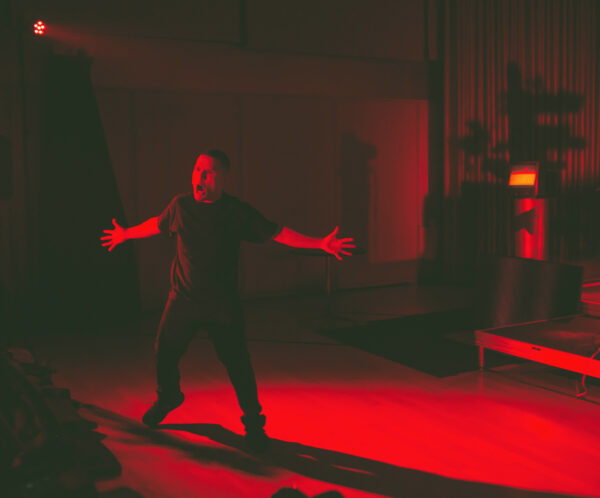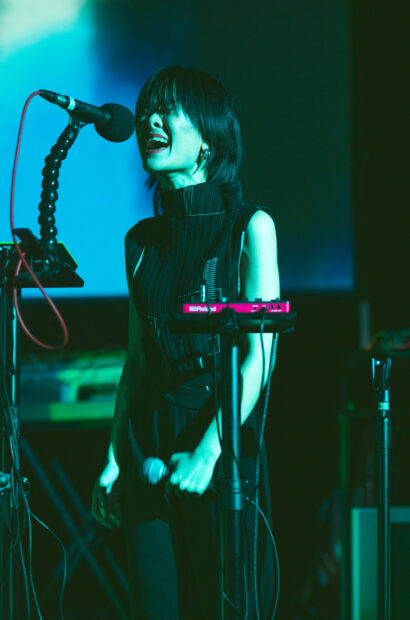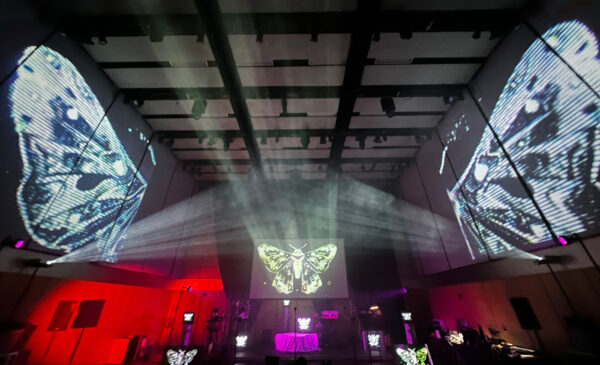In May of 2018, artist and educator Dean Terry presented The Alexa Dialogues at the AT&T Performing Arts Center (ATTPAC) in Dallas’s Arts District. The show was a performance from his intermedia troupe, Therefore, and was segmented into many skits, performed by a cast of local artists (Abel Flores Jr., Hilly Holsonback, and Hannah Weir). The Alexa Dialogues made use of an Amazon Alexa, which was then manipulated to interact with the actors on stage, blurring the lines of technological and human performance. In the first weekend of June this year, Terry returned to ATTPAC with another theatrical performance, Poems for Broken Screens, which had a greater emphasis on music as a part of the ensemble. I spoke with Terry about the process of creating his avant-garde theatrical show.
William Sarradet (WS): Would you please tell us the name of the studio in which this show was developed?
Dean Terry (DT): The space is called Anechoic Chamber and Transmedia Studio (ACTS) [at the University of Texas Dallas], and I lead a research group and mentor MFA and Ph.D. students in creative process and related research.
WS: How did this show’s development compare to The Alexa Dialogues, in terms of time?
DT: The total time was actually less, even though the performance was longer and we developed more pieces (a significant number of which were cut). The Alexa project included a year of preproduction spent experimenting with device programming. Then we created the pieces. The Poems project started at the end of last summer and I worked on it 12-16 hours a day until you saw it. The group worked many long hours and some were not able to keep up. We lost a few people along the way. Those still there at the end were deeply committed.
In addition to time, the economics of a project like this are interesting and somewhat troublesome. The audience for experimental work is limited in this region, which means that the execution has to be minimal and the scope modest, or the funding has to be external and generous. If we want whatever ambitious avant-garde is here, we are going to have to commit to funding it. In addition to the venue, I am grateful for the generous support from the University of Texas Dallas.
WS: The piece Soft Bells; Leap with Yves was especially impactful. In it, many screens on and above the stage flash solid color, breaking from some of the roughness of the visual and sonic qualities of the show overall. The show’s program also gives special thanks to Laurie Anderson. Can you speak to some of this show’s references or inspirations?
DT: Soft Bells is mostly Patrick Murphy’s contribution. He made the original track on a modular synthesizer and I added some melodic and percussive elements on top. Critically, he had the idea that the visual part would be a respite from the rough textures, as you say, and the more challenging pieces that preceded and followed it. Patrick often provides a check on the noise and chaos that I appear to have a high tolerance for. He also has a complimentary sonic and visual aesthetic and is a very good painter, so I rely on him for feedback on whether things are working sonically or visually. The flat, noiseless colors, which he chose, are also one of the few times we achieve a kind of visual minimalism. There’s an internal joke in the group that we are failed minimalists. I always aspire to it and attempt to apply minimalist principles everywhere, but you’d never know it by seeing us or looking at our abominable cable management. Soft Bells is a place where we were within sight of something like minimalism.
In audio, distortion reveals additional sounds and overtones that were there but not audible. I think this also works in images and other media. With distortion, amplification, and scale, things are revealed and emphasized that sometimes turn out not too obscure, but rather elements are revealed that sometimes turn out to be more important than the source image, sound, gesture, or words. This is why we mostly make live work at high volumes and at large visual scales. A good deal of what we are trying to achieve is only possible through magnification of scale (and manipulation of time), and then we use that as a measure of contrast for quiet moments and small visual and sonic details.
In terms of inspiration, I doubt I would be doing any of this had I not seen Laurie Anderson early on in art school. She was doing her full-on multimedia work then, with sound triggers, projections, voice transformations, the whole thing. I like to think we are somehow downstream of her monumental work, and honoring it the best we can. In the Alexa show we thanked Brian Eno, who influenced the way we sound. And of course, Hilly, Abel, Patrick and everyone else bring a world of influences to the group.
In terms of references, there are several. One of them is Yves Klein, to whom we dedicate an entire piece, A Leap with Yves, that riffs on his Leap into the Void image, which is iconic and was inspirational to me early on. It also has a fakery that still resonates in our current AI era. As a professor of creative practice (really, process), I insist on taking artistic practice seriously, not as an identity accessory or pastime (whatever that means), but rather as a worldview, which means there are religious and philosophical elements whether they are recognized or not. (I’ve written about this before in Glasstire).
I’m influenced by artists of all kinds who create worlds and fully inhabit them, and that’s why they are referenced. We also reference Jim Morrison in the Leap piece, but change the words from “break on through” to “swipe on through to the other side,” reflecting current screen technology. Morrison was of course referencing William Blake. All of this is part of a deliberate pattern of callbacks in time — shared public time but also things that happen in the performance (the “sun” that moves across the ceiling near the beginning and at the end, for example). It’s also part of my ongoing ignoring of genre distinctions and their rules about what kind of subjects and references are allowed.
WS: Local musicians Paul Slavens, Kit Presley, and Patrick Murphy joined the performance this time. Was it a conscious decision to make music more of a focal point of this show?
DT: Therefore was originally, and for many years, a solo recording project. I had parallel practices in visual art, video, film, and writing. It wasn’t until I met Hillary Holsonback, Hannah Weir, and Abel Flores that I thought to make a new Therefore that combined all my creative interests. So sound and music are foundational. It also distinguishes us from some adjacent disciplines, where music and sound are more decorative or play a purely supportive role. The music has to be able to stand on its own and we worked hard to make sure that it does. And sound itself as an element is foundational to what we do. Even sound is hand-crafted, like everything else. This time we also employed quad sound [also known as surround sound], designed by UTD graduate student Tyler Haws. This allowed us to create an atmospheric sonic environment, as well as disorienting effects.
WS: I enjoy the segmented nature of the show, and that it expressed the many approaches to theater as a format. What do you want people to take away from this presentation?
DT: I do Therefore in this format partly because I like the challenge of designing live pieces, which, as I’ve stated, have their own set of difficulties. For us, difficulty transformed into art becomes joy. I hope audiences feel this.
For this one, the desire to create instability is still there, but backgrounded. With Poems, I hope we have crafted the individual pieces well enough and with a clear contrast between them so that viewers can experience a range of states, rather than just a few; that time has been structured in unexpected ways; that sonic, visual, textual, or perforative elements that may normally be experienced as background became foregrounded. In music concerts, images are often decoration. In theater, the music often is. I want all the elements to be well-crafted and important, even as one or another is foregrounded.
WS: Could you expand upon your approach to building a stage show that addresses concerns about technology, while retaining the ambiguities that art allows?
DT: There’s technology embedded in every piece in some way, but it’s just that, embedded. I wrote a sort of love poem for Hilly to interpret and perform called “New TV,” where she gazes into a 30-year-old analog TV and remembers a lost love, using the TV as a friend (like we are starting to do with AI) and a medium, but it’s all an illusion — though a rather lovely one. But what makes that piece work with all the tech running is her performance, her voice, and her image. All the machinery is in service to that. If there’s mystery it’s her delivery, that dominates the platforms supporting her.
These platforms are designed as composite instruments, which makes everyone on the team a performer. Everything related to time in the performance is about one or more people in the group coordinating something like a jazz band or dancers in determining when something gets louder, quieter, brighter, or darker, etc. There are cameras everywhere, with live cinematography performed by Kyle Kondas, which creates live video art. And we turned the spotlight into an instrument handled by Kad Penney, at one moment deliberately poorly, and in the next very precise. It becomes a symbol of the sun in multiple places. So, rather than just technicians, those running the equipment are improvising as fellow artists. I think this also distinguishes us from many other kinds of live media.
None of the work is really about the tech, and we work with it to get the effects we want, but we certainly don’t respect it (TVs were destroyed the final evening). A lot of art and tech is about the tech, or what I call “gee whizzery,” where we are wowed by this or that technical ability, but it feels like nothing and is just decorative or clichés. I have no interest in that. We used everything from ancient analog gear to the latest software. Whatever serves each individual piece. The internal logic of each work decides. Often, the dumbest thing a device will do or how it will fail is the most interesting, so we’ll layer that in. I don’t believe in “best practices.” All the layers add to the ambiguity, which is a good way of saying it.
WS: Throughout the show, Abel Flores Jr. gives a few 10-second-long corporate-sounding presentations about “words,” which I found especially satirical. How are you choosing to pace the skits in a show like this?
DT: The ten-second “tiny talks” came from Abel doing them over the years in rehearsals to crack us up. He would walk up, start to say something seemingly profound, and then abruptly walk away. It’s very Therefore, which has always been about upending logical structures and reason. We’ve added more humor over the years, and a lot of it comes from us trying to get a rise out of each other. The trouble is presenting an inside joke with the context needed to make it work as intended to an unfamiliar audience.
Finally, I like the idea of making super short pieces. It’s challenging to pull them off because the timing has to be impeccable, as does the ability to transition in and out of them. Hilly also has some comedic parts, and these too were things that were just killing us in rehearsal and we weren’t sure whether they would translate to our audience, but it appears they did. When she does the incredibly difficult cold open and then comes back a few minutes later as a male middle school principal, it’s very gratifying to watch as a collaborator.
In terms of sequencing, it’s like an album, except we are also taking into account the emotional state of the performers. The first and last sections are well-sequenced and themed, with the middle section being a bit more modular to account for breaks for Hilly and Abel so they can recover from and prepare for their pieces.
WS: The Alexa Dialogues interrogated the idea of an artificially intelligent home assistant as a stage character. Poems for Broken Screens puts the acting talent back into the hands of human actors. Do machines still have a voice in this show?
DT: I’ve been thinking about and researching what is popularly called AI for several decades. Alexa Dialogues was partly an artistic exploration of where I was with it at that time. Companies were working hard to make these systems seem like people — pleasant, compliant people with accents of your choosing. Many of us were tricked into welcoming these things into our lives. I tried to explore what happens when we interact with systems like people and imagine various scenarios several years out. We are there now.
For Poems, most of it was written before the current hype cycle started earlier this year. But AI is all through the work, like people used to say about the internet: invisible, behind the scenes like electricity is. Much of the imagery had origins in generative AI platforms. The moth in Moth, the people jumping in Leap with Yves, and all the imagery in The Map of___, including the rooms that made no sense. AI imaging, in its current generation, is already doing unintentional dada. And we trace part of our roots to dada, but with intention. So it’s part of the process, even as we are highly unsettled about the nature of AI itself.
We used current AI tools like everyone else has been doing, except we let it have its way. We submitted. We aligned to it, rather than expecting the opposite. This is a subtle, less foregrounded reference and commentary on AI and our previous work. We are in a moment where unpredictable changes in arts and culture are about to happen, like the Enlightenment, the industrial revolution, and the Internet era. Still, it’s hard to see it or make art in relation to it, rather than be subject to it. I expect we will do more work on this soon, and Poems may be the last project that is not fully marked by the changes happening at this very moment. But we are paying attention, and hope other artists are as well.
WS: Will the performance be viewable online?
DT: Yes. We are making a film of the performance. Each piece will have a separate video and there will also be a film shot by Garrett Chase that captures the entire performance in the order it was presented live. We are also publishing a book with photos, the full script, and commentary on each piece. Both will be available later this year, with clips appearing on our media channels before then.
Poems for Broken Screens was performed at the AT&T Performing Arts Center’s Hamon Hall from June 1-3, 2023.
William Sarradet is the Assistant Editor for Glasstire.






